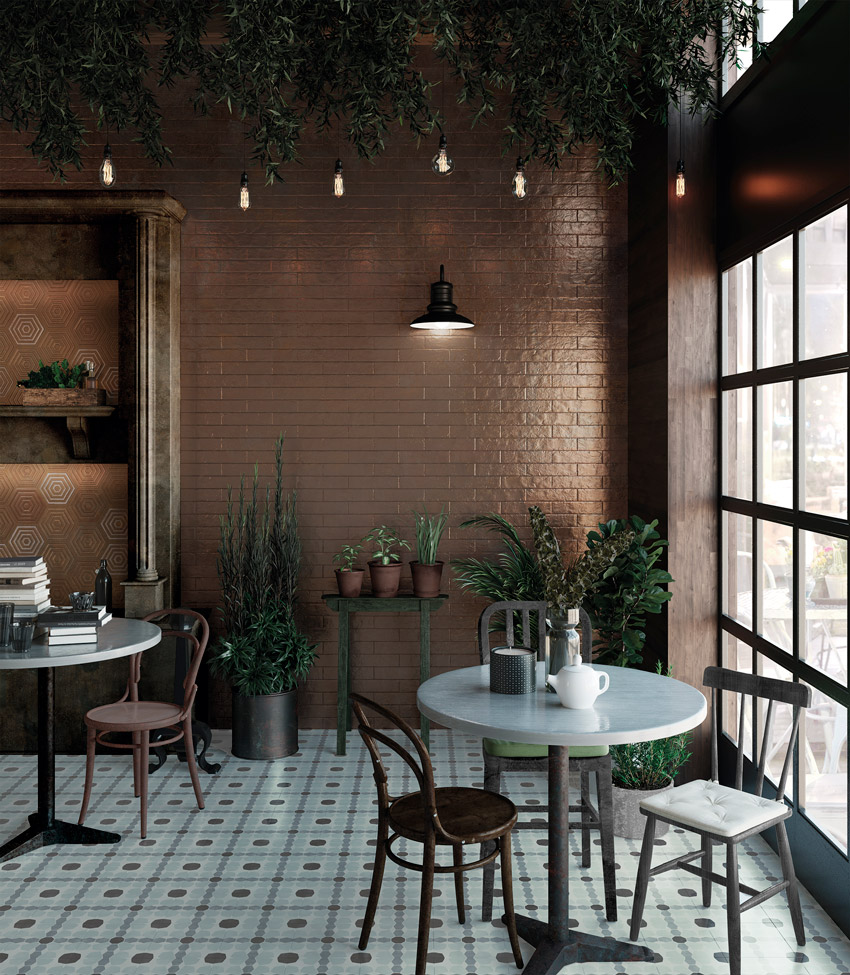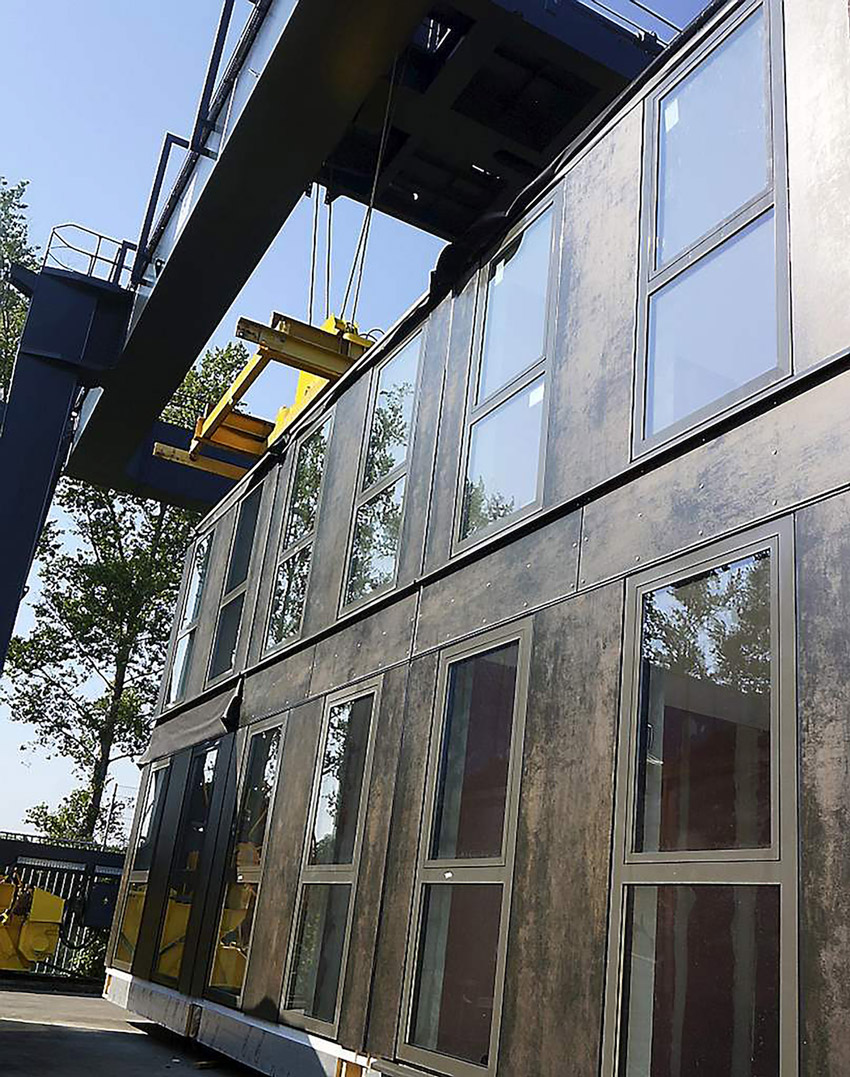Technology Transforms Tile
THIN-GAUGED PORCELAIN: LOSING WEIGHT WHERE IT COUNTS
At the very thin end of the spectrum (3.7–5 millimeters), thickness and weight are reduced as much as possible to meet or exceed mechanical requirements for specific environments. The reduction has a dramatic impact on the cost of tile in a project and the range of projects where tile can be effectively used.
In general, reducing the thickness of a tile by 1 millimeter (0.04 inch) equates to a reduction in weight of 10 percent. This is based on the 10-millimeter median thickness of traditional tile.
Ocean freight, inland trucking, rail, and duties are a large factor of landed cost (the total price of a product as it arrives at its ultimate destination). This freight cost accounts for approximately 30–45 percent of a tile’s cost to its end user in North America, depending on the port of origin and how delivery-to-door weight allowances are calculated.
The impact on landed cost from reduction in thickness of a tile product can be indicated in a simplified way as follows:
Landed cost equals (product cost per square foot) plus (delivery charges, inland trucking) plus (container cost) divided by (square footage per container by weight).
The freight cost component—which, as noted above, accounts for 30–45 percent of the product’s cost—is reduced by 10 percent per millimeter. The reduced thickness of the tile allows for more tile to be packed into each container.
The reduced weight lowers delivery charges during the initial phases of transportation, but the savings continue to compound throughout the project, as detailed below.
- Product lands at distributor, and markup is factored. Overhead (trucking to branches, marketing, etc.) is factored into the product cost prior to setting the sale price. Lower landed cost for the distributor means the standard markup percentages are applied to smaller numbers, translating to a lower cost for the consumer.
- Job packing and deliveries. Again, lower weight of the material means that the cost of contractors or private delivery companies is less per square foot of material as the product moves from the point of sale to the job site.
- On-site labor. The lighter-weight material often requires smaller crews to move material around site and fix to the surfaces, again lowering the overall cost. Gauged tile is also easier to cut and maneuver, and—with an experienced installation crew—can save installation cost and complexity.
There are other advantages of thin-gauged porcelain tile in addition to financial costs. For example, with very large-format thin slabs, there are fewer—and almost invisible—grout lines. This is an obvious advantage in residential kitchens and bathrooms, and the aesthetics can be spectacular in many types of spaces; for example, with the use of very large-scale digital graphics shown in the previous photo.
But the minimization of grout is highly functional as well; for example, in applications like restaurants and health-care facilities where grouts can collect grease or bacteria. In commercial bathrooms or other high-traffic areas that must be easy to clean frequently and quickly, thin low-grout porcelain can be applied directly over older, worn, or higher-maintenance tile floors.
Specifying the thinnest tile effective for the application also has a positive environmental impact, beginning with lower consumption of raw materials from the outset. For many state-of-the-art manufacturers already optimized for producing gauged tile, equipment and procedures are also in place to achieve substantial energy savings. After manufacturing, the ability to load significantly more of the thinner, lighter tile into containers and trucks not only reduces financial cost but also emissions of CO2 and pollutant substances.
The light weight and enhanced performance properties of the thinnest-gauged porcelain tile are opening up creative possibilities in traditional interior applications and decidedly nontraditional applications, as outlined in the following sections.
Renovation
The use of gauged porcelain tile is growing rapidly in renovation. At a little more than 1/8 inch thick, new thin-gauged tiles are conceptually a solid-surface ceramic laminate. They can be installed directly over a sound and prepared existing tile installation. For floors, the old ceramic tile acts as a solid substrate, and the slim tile is mortared over it. Using slim-gauged tile in this way saves time and cost and eliminates waste to be hauled away to the landfill.
The durability of the new tile means that the renovation cycle, typically around six to eight years for public spaces, can be extended to many decades. In applications such as hotels and health-care facilities, this also significantly reduces costly time and disruption required for each refurbishing,
High-Performance Veneer for Worktops, Cabinetry, and Furniture
An example of utilizing the physical characteristics of porcelain tile in new ways, porcelain tiles in slightly thicker profiles, in the range of 12–30 millimeters (around ½-1 inch), are being used to create performance worktop and countertop surfaces. Using advanced digital decoration techniques, the surfaces can be specified with the look and feel of almost any material. In one pioneering system, full through-body decoration allows edges to be profiled like any other solid surface material, and the veining structures are homogeneous throughout the material. Another inventive application brought together tile manufacturer and induction-range manufacturer to laminate an induction cooking surface inside the slab. Tile’s hardness, high thermal mass, and low conductivity make it the only material physically suited to this type of system. These and other similar designs mean that cooks can prep, cut, cook, and eat on the same seamless kitchen surface, which can then immediately be used as a dining table or, as in the photo below, a desk or worktable.

Photo courtesy of Tile of Spain
Worktops using laminated gauged porcelain slabs less than a half-inch thick can integrate cooking, eating, and working functions into ceramic tile surfaces.
Acoustical Ceilings
Traditional drop ceilings used in corporate and other commercial spaces are often afterthoughts at best, with specifiers left selecting the least-offending option rather than something that could be a positive design feature. Utilizing gauged porcelain tile can offer unlimited design possibilities, but the tile can also be a component of an acoustical drop ceiling with high R-value and near-zero flame-spread ratings. Some manufacturers are now specializing in this niche by adding sound-dampening backings and surface textures in formats that can be integrated into common track systems for suspended ceilings. The ceramic tiles provide an exceptional aesthetic, thermal, and acoustic option.

Photo courtesy of Tile of Spain
Advanced gauged porcelain tile is light and thin enough to be adapted for use in acoustic ceilings and high-traffic floors, and produced with surface textures and patterns duplicating a wide range of other materials.
Ventilated Facades
Curtain-wall or rainscreen applications of ceramic tile panels installed on exterior walls with metal railing systems are highly energy-efficient and weather-resistant forms of exterior cladding. A physical separation is created between the outside of the facade and the structural wall of the building, allowing exchange of air. The facade material is advanced gauged porcelain tile, usually ranging from 3.7–12 millimeters (about 1/8 to ½ inch) depending on the fastening system and dynamic load tolerances of the structure.
These innovative thin, light facades can be engineered to optimize for reducing passive heat loss or gain depending on surrounding climate and building needs by adjusting the depth of the air chamber between the structural walls and the facade. Energy usage for HVAC systems can be reduced by up to 30 percent solely by incorporating one of these systems.
See the Forward Facades sidebar for more information about two exceptional examples of gauged porcelain tiles used in exterior cladding, such as the Laan van Spartaan student residences in West Amsterdam, which utilized gauged porcelain sheets 3 millimeters and 5 millimeters thick, in panels up to 1,000 by 3,000 millimeters, as in the photo below.

Photo: Michael Van Oosten
The exterior cladding on Laan van Spartaan student housing in Amsterdam utilizes gauged porcelain sheets, 3 millimeters and 5 millimeters thick, in panels up to 1,000 by 3,000 millimeters.










